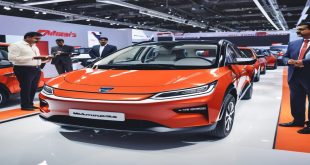Gyroscopic transport: A unique project known as second-level transport developed by Dahir Insat Company once again brings forward the idea of an alternative mass transportation system similar to the transit elevated bus. This massive bus crawls the
street like a moving bridge. Dahir Insat, however, gives it a little bit more sophistication by using telescopic racks rather than rigid supports. The roof of the deck is fitted with solar panels for constant charging.
Each of the six racks has its own motor and sensors to recognize what’s happening on the street. These racks move on a specially designed steel rail on top of the existing road surface. The company says the cost of building the rail network is much cheaper than that of traditional concrete or asphalt surfaces. Each time a car or any other vehicle is blocking the rail, the racks can simply lift up and down independently to overstep the obstructions, which means gyroscopic transport can avoid
Currently
underground rail network, but the tunnels are designed for electric cars, not trains.
The entryway to the tunnel is an elevator trolley that takes any
car from a normal road directly to the lower level. At this point, the car doesn’t actually need to use its own propeller mechanism.
The electric trolley hauls the car through the tunnel to the next city or exit point
and finally lifts it up again to access the normal road.
When the system is operational, the road networks will look like a two-story structure.
The trolley is constantly connected to the power source and can travel up to 124 miles
per hour in the tunnel, all without draining the car’s battery or fuel.
Airbus Pop-Up. The search for a truly reliable and futuristic flying car has been going on for decades.
One of the latest ideas is the Pop-Up Next made by a joint venture of Airbus, Audi and
Etal Design. The vehicle would be autonomous and the plan is pretty simple too.
Passengers will book their trip on a Pop-Up via an app.
PopUp then automatically suggests the most efficient route in accordance with passenger-specific preferences configured on the app as well.
First option would be transportation by road, but when it gets congested, PopUp will detach the passenger capsule from its ground module so the air module can fly it to the destination. The concept is to develop a modular ground and air passenger vehicle with three major components. passenger capsule made of carbon fiber, electric powered ground module, air
module powered by rotor propulsion system. Technically speaking the pop-up
is already very close to a form of new transportation which can be produced
right now. Renault Float. Renault Float was the winning design at the 2017
Car of the Future competition held by Renault in collaboration with Central
St. Martin’s University. The pod-like vehicle looks like a floating bubble,
with each bubble seating up to two passengers. Not only is Renault Float a
levitating vehicle, it’s also modular in a sense that pods can attach to each
other using a magnetic belt without having to stop for the process. Since
the Float doesn’t actually touch the surface of the road, ride and comfort
is a guarantee. The Aero mobile is a fascinating vehicle for several reasons.
First off, it’s a real flying car. Yes, that can actually fly in real life. In an amazing feat of engineering,
the designers of the Aeromobile have managed to combine this functionality
with a sleek and eerie beauty that makes this vehicle a true work of art.
You can make use of the Aeromobile for its aerial capabilities or its more mundane road-traveling capabilities.
But rest assured, whatever mode you pick, it’ll take you to your destination with the style,
elegance and efficiency that you’ve always dreamed of but never knew you could achieve.
It’s been reported to transform into flight mode in just under three minutes, gaining
the ability to travel as far as 223 miles per hour and cover 466 miles.

It’s no slouch when it’s in car mode either with a breathtaking top speed of 100 miles per hour.
The Aeromobile is faster than most traditional flights and is less stressful and time consuming
than traveling through a traditional airline or ordering for a helicopter. Of course you’ll need
a pilot license to operate this vehicle in Europe where it’s certified to run and fly
as well as access to a runway. If you’re in the United States then the Aeromobile may not
be available to use, but work is underway to ensure its release as soon as possible.
Rolls-Royce Vision Next 100 With the shimmering silver-green color and oversized fenders,
the Rolls-Royce Vision Next 100 looks otherworldly.
Most Rolls-Royce production cars throughout the history of the company
have always pushed the boundary of what a luxury car should be.
Now that BMW has given them the chance to build a concept car,
The result is a breathtaking combination of future technologies and old-fashioned lavishness.
The silhouette is still pretty much a Rolls-Royce.
It has the signature vertical grille, long hood, massive wheels, suicide doors, and
of course the spirit of ecstasy. As massive as it looks, the concept is only 5900mm long or 184mm shorter than
the Phantom Extended Wheelbase. Bear in mind, however, that the prototype is not a four-door sedan.
It provides seating for just two on a front-facing sofa bench positioned at the rear of the
fancy cabin. Mounted on its modern carbon fiber structure is a range of old-school luxuries like hand-woven
wool carpet, real wood, and silk chair.
The autonomous car is all-electric powered by two 250-kilowatt motors, one in the
back and another at the rear. It has no pedals, steering wheel, or any other mechanical linkage under that long hood.
Terra Fugia TF-X Another flying car, and this time the company describes it as
the flying car for all of us, which perhaps is accurate assuming everyone has a pilot
license or can afford a flying car. Known as TF-X, Terra Fugia has fitted
it with a hybrid powertrain to propel the wheels on the ground and two
electric rotors for flying. The vehicle does its takeoff vertically
instead of requiring high speed run before airborne.
Maximum speed is around 200 miles per hour
and once airborne, TFX can reach 500 miles of range, which means the four seats flying car
can take you from Geneva to London
in just about three hours.nUnfortunately, it remains unclear
whether Terra Fugia will bring the concept
to further steps of development. So at this point, the TFX is not yet ready for sale.



